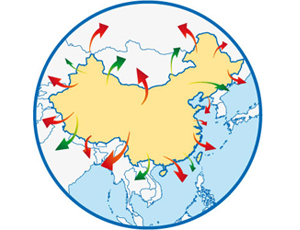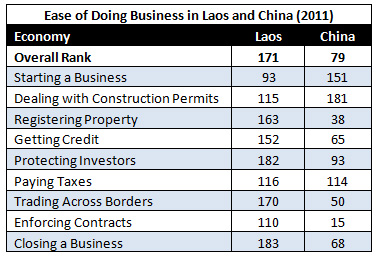The China Alternative – Laos
 The China Alternative is our series covering other manufacturing destinations in emerging Asia that may start to compete with China in terms of labor costs, infrastructure and operational capacity. In this issue we look at Laos.
The China Alternative is our series covering other manufacturing destinations in emerging Asia that may start to compete with China in terms of labor costs, infrastructure and operational capacity. In this issue we look at Laos.
By Simon Sheung
Aug. 18 – On December 9, 2010, the people of Laos celebrated the official opening of the Nam Theun 2 Hydroelectric Dam. Currently the largest of its kind in Laos, the dam was built on the Nam Theun River, and is capable of generating up to 1,070 megawatts of electricity, 95 percent of which will be exported to Thailand. The project is expected to generate US$2 billion in revenue over a 25-year period, and will play a key role in accumulating funds for the Laotian government’s National Growth and Poverty Eradication Strategy. In many ways, the successful opening of the Nam Theun 2 is a testament to Laos’ path towards greater socioeconomic development, and highlights its transition from a country wrought by political struggles to an emerging economic force in Southeast Asia.
General overview
The Lao People’s Democratic Republic, better known as Laos, is a land-locked state nestled in the middle of the Southeast Asian mainland. With a total area of 236,800 square kilometers, the country shares borders with Cambodia to its south, Vietnam to its east, Thailand to its west, along with China and Myanmar to the north. As one of the least populated countries in Southeast Asia, Laos boasted a population of approximately 6.5 million in 2010. However, the country is very much culturally and ethnically diverse, with only an approximate 55 percent of the country’s population identifying themselves as Lao, 11 percent Khmou and 8 percent Hmong. The remaining 26 percent is made up of people from the neighboring countries of Thailand, Vietnam and China. Laos’ official language is Laotian, with English and French being secondary languages.
Laos’ capital is located at Vientiane, which is the largest city in the country, as well as its political and economic center. On the whole, Vientiane is a relatively small city with only 800,000 residents and is home to many of the country’s ancient temples and monuments.
Historical overview
The earliest recorded history of a unified state in Laos was the Kingdom of Lan Xang in the mid-14th Century. Literally meaning the “Kingdom of a Million Elephants,” Lan Xang was a powerful state that was known for its large army of war elephants. The kingdom spanned a wide area in what is now Thailand and Laos and, through its political influence, the state helped spread Buddhism as the predominant religion in the area. Today, around 65 percent of the population in Laos still practices the religion.
The monarchic system would last for about 500 years until the arrival of the French during the latter half of the 19th Century. French colonials eventually took over much of Vietnam as well as a large portion of Southeast Asia. By then, Lan Xang had been fractured into a collection of feudal states that paid tribute to the king of Siam. After a bitter struggle, Siam eventually surrendered all its territory east of the Mekong River to the French in 1893. The once mighty kingdom thus became a part of the French empire.
The French would have a strong hold in Southeast Asia until after the end of the Second World War, when there was a power vacuum left after the Japanese invasion. At that time, there was a period of intense nationalism among the once-subjugated Lao people, leading them to declare an independent nation in 1945. By this time, the Communist movement had spread to Southeast Asia, and the conflict in ideology eventually boiled to the French-Indochina War between France and the Communist forces of Southeast Asia.
The Communist forces eventually proved victorious and the Lao People’s Democratic Republic was formally established in 1975. From then on, the new Communist government created a command economy along with strict security measures. This included total control of the media and the establishment of “re-education camps,” institutions which jailed many supporters and dissidents from the previous government. These policies eventually led to hard oppression and economic decline, causing many Laotians to flee the country.
It is estimated that since 1975, approximately 10 percent of Laos’ population (300,000 people) claimed refugee status and settled in western countries such as the United States, France, Canada and Australia, while more than 40,000 fled to neighboring Thailand. The mass exodus of the Laotian people continued until the late-1990s, when the Lao government gradually eased its policies, closing many of its camps and releasing its prisoners.
Economic overview
While Laos retains its Communist leadership today, it has begun to foster a free market economy and relax its control on media and security. Despite being an agrarian economy and still highly dependent on foreign aid, Laos has enjoyed a long period of economic growth, and is fostering improved ties with the international community. It is a member of the Asia Pacific Trade Agreement and the Association of Southeast Asian Nations. Laos applied to join the World Trade Organization in 1997, and its membership is still under consideration.
In 2010, Laos’ GDP reached US$15.7 billion, and it was estimated to have grown 7.7 percent from the prior year. Since introducing free market reforms in 1986, Laos’ economy has experienced GDP growth of over 6 percent per year, with the Asian Financial Crisis in 1997 being the only exception. Subsistence agriculture is still a major pillar of the Lao economy and accounts for about 30 percent of GDP and provides employment for up to 75 percent of the population. However, together with a higher focus on civil projects and increased foreign aid, government spending in public infrastructure is also becoming a large driving force.
Currently, Laos is still known as one of the world’s poorest countries, and is on the United Nation’s list of least developed countries. Much of its growth is supported by aid from other countries, and on average, it is estimated that foreign aid accounts for 70 percent to 80 percent of its annual budget.
Laos’ exports added up to US$1.95 billion in 2010, and goods are often sold to Thailand (27.9 percent), China (20.1 percent), Vietnam (14.9 percent) and the United Kingdom (4.1 percent). Most of Laos’ exports include woodcrafts, agricultural products, copper, tin and gold. Electricity has long been a major export after the construction of large-scale hydroelectric projects along the Mekong River. As a country interwoven with rivers and saturated by heavy rainfall, Laos has huge prospects for hydroelectric power, and has an estimated potential of producing up to 26,500 megawatts per year.
Most of Laos’ imports are finished products, which include machinery, construction equipment, vehicles, fuel and general consumer goods. In 2010, imports amounted to US$1.50 billion, and come mainly from Thailand (62.2 percent), China (14.3 percent) and Vietnam (6.4 percent).
Foreign investment
In terms of foreign direct investment, Laos’ Department for Promotion and Management of Domestic and Foreign Investment (DDFI) accepted approximately US$1.4 billion worth of FDI in 2010, most of which was used in the country’s civil projects. Financing often came from countries such as Vietnam, China, Thailand, Malaysia, Singapore, Korea, France, Japan, India and Australia.
To facilitate foreign investment, the DDFI has a host of tax and duty incentives for would-be investors.
The DDFI grants all approved foreign investors an incentive tax rate of 20 percent, as opposed to the local tax rate of 35 percent. According to the department, this rate applies to foreign investment in any sector of the economy and does not depend on company or performance. Also, foreign investors and other expatriates pay a flat 10 percent personal income tax.
A list of non-tax incentives include:
- Permission to bring in foreign nationals for financial research and feasibility reports
- Permission to bring in foreign technicians, experts, and managers
- Permission to lease land for up to 20 years from a Lao national and up to 50 years from the government
- Permission to own all improvements and structures made on the leased property, transfer leases to other entities, and permission to sell or remove improvements or structures
- Guarantees against nationalization, expropriation, or requisition without compensation
Despite having a huge prospect for growth, it is still relatively difficult to do business in Laos. This is mainly due to the fact that the country is in the midst of a political and economic transition, causing much of its current laws and regulations to be highly questionable. On an economic survey of 183 nations conducted by the World Bank and International Finance Corporation in 2011, Laos was ranked 171st in regards to the general ease of doing business. According to the study, Laos is ranked lowest in terms of closing a business and protecting investors, placing 183rd and 182nd respectively. Its highest position is at starting a business, which is moderately ranked at 93rd. Compared to China, Laos only outranks the former in starting a business and dealing with construction permits. Overall, the complications in doing business in Laos are stemmed from the country’s under-developed commercial laws and unpredictable government policies.

Conclusion
Laos’ government has been administered by the Lao People’s Revolutionary Party (LPRP) since 1975. While it is essentially a communist organization, its leadership is still adapting to the free market practices that were introduced not long ago, and many problems arise from this shift. Corruption is a major issue amongst public officials, many of whom have been criticized for redirecting public resources to serve their own ends. Currently Laos’ most pressing concern is its high rate of inflation, which has distorted the country’s economic growth. According to the Economist Intelligence Unit, the rate of inflation reached 8.1 percent year-on-year in September 2010, exceeding the overall 7.7 percent economic growth for that year. In spite of these problems, the government has refused to make cuts on fuel import taxes or invoke fuel subsidies. While this would lighten the burden on production costs, the government reasoned that it would also reduce government revenue, and asserted that its main priority is to merely keep inflation under the national growth rate.
Overall, Laos still has a long way to go in becoming a destination for feasible investment. While it has remarkable potential in becoming an engine of growth in Southeast Asia, its political and economic infrastructure is still in a critical phase of development. As a result, the country faces continued issues such as human and drug trafficking, corruption, lack of human resources, and environmental degradation. However, with strengthening governing policies, as well as continued support from international circles, Laos has pledged to shed its “least developed” status, and become a country where both social and economic development can be sustained.
Related Reading
 The China Alternative Series
The China Alternative Series
Our complete series on other manufacturing destinations in Asia that are now starting to compete with China in terms of labor costs, infrastructure and operational capacity.
 China’s Neighbors
China’s Neighbors
This unique book is an introductory study of all 14 of China’s neighbor countries: Afghanistan, Bhutan, India, Kazakhstan, Kyrgyzstan, Laos, Myanmar, Mongolia, Nepal, North Korea, Pakistan, Russia, Tajikistan and Vietnam.
 Operational Costs of Business in China’s Inland Cities
Operational Costs of Business in China’s Inland Cities
It is widely held that land and labor costs in inland provinces offer quite significant cost savings over major east coast and southern cities. In this issue, we take a quick look at the numbers behind these beliefs.
![]() 2point6billion.com
2point6billion.com
Our popular emerging Asia website and commentary dealing with China, India and other regional nations multilateral development, trade, investment and politics.
- Previous Article China Encourages Private Enterprises to Invest in Strategic Emerging Industries
- Next Article Running Background Checks On Chinese Companies



























